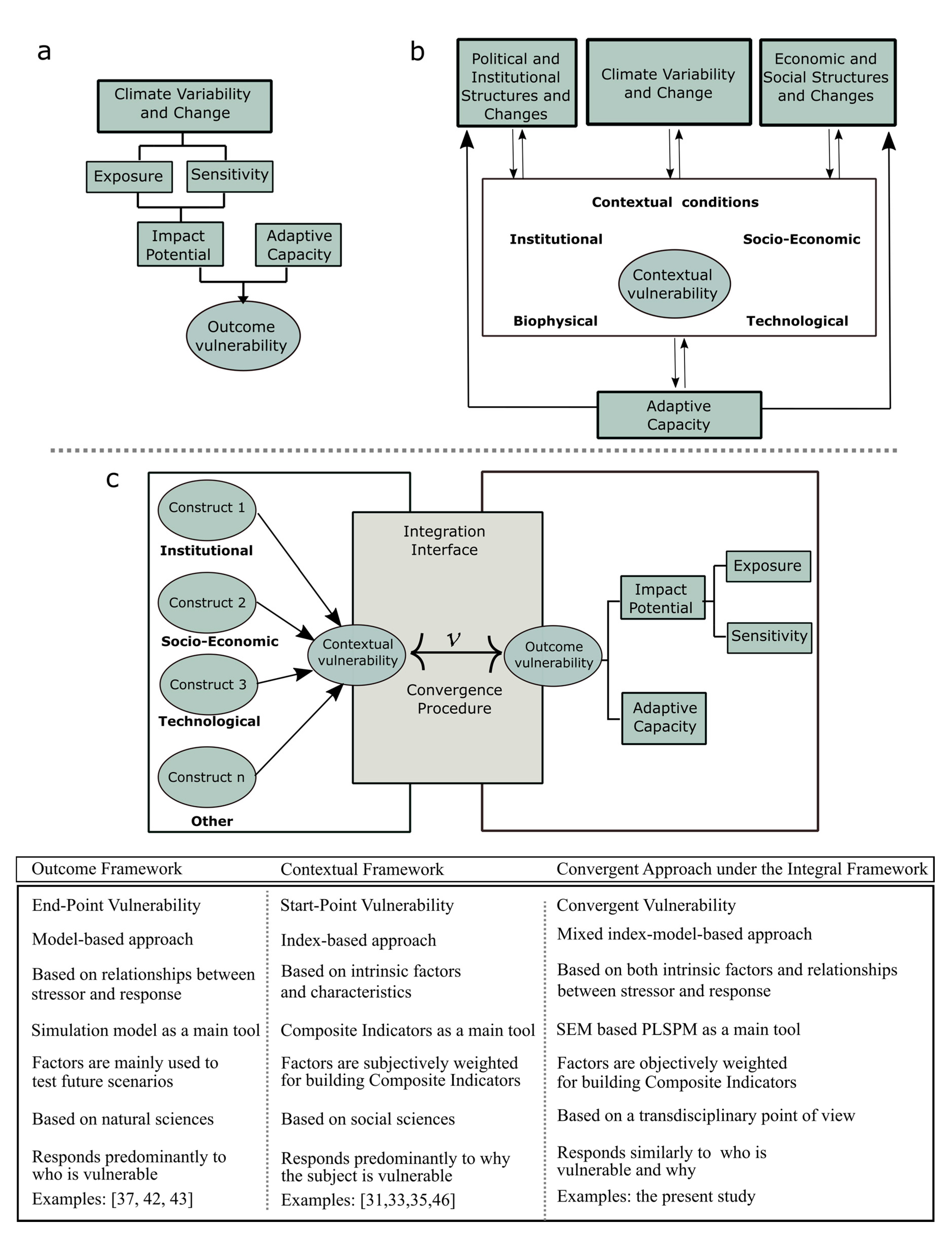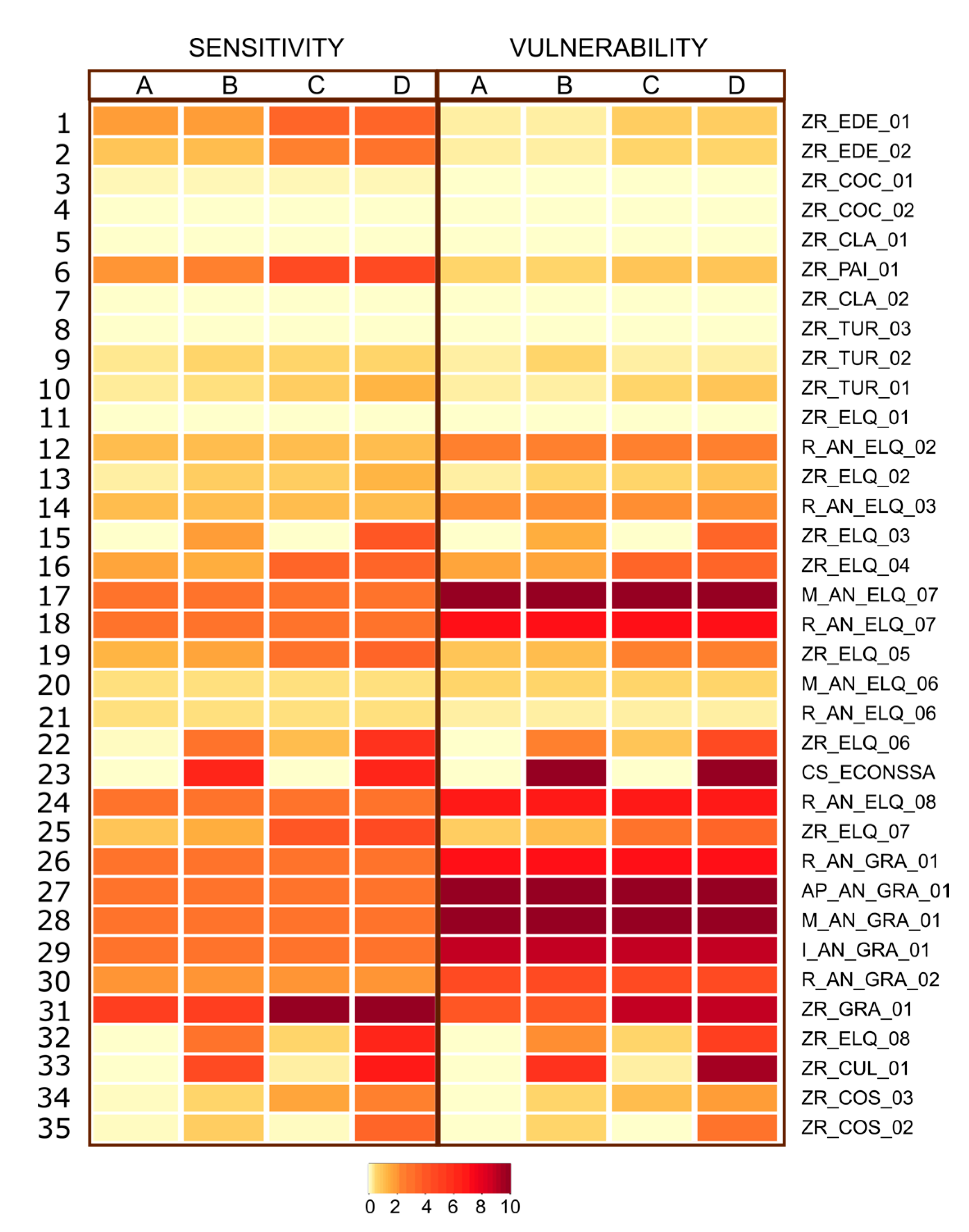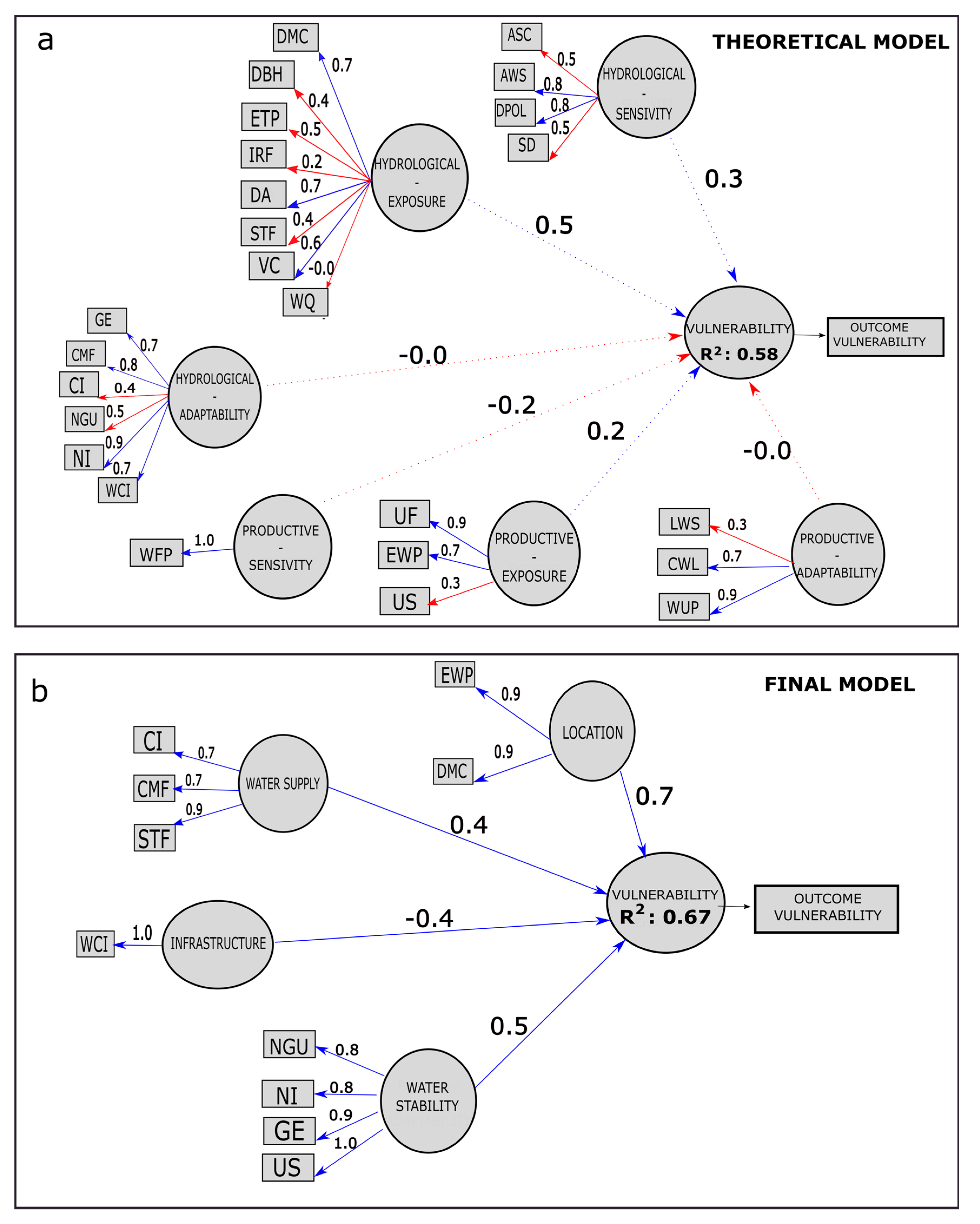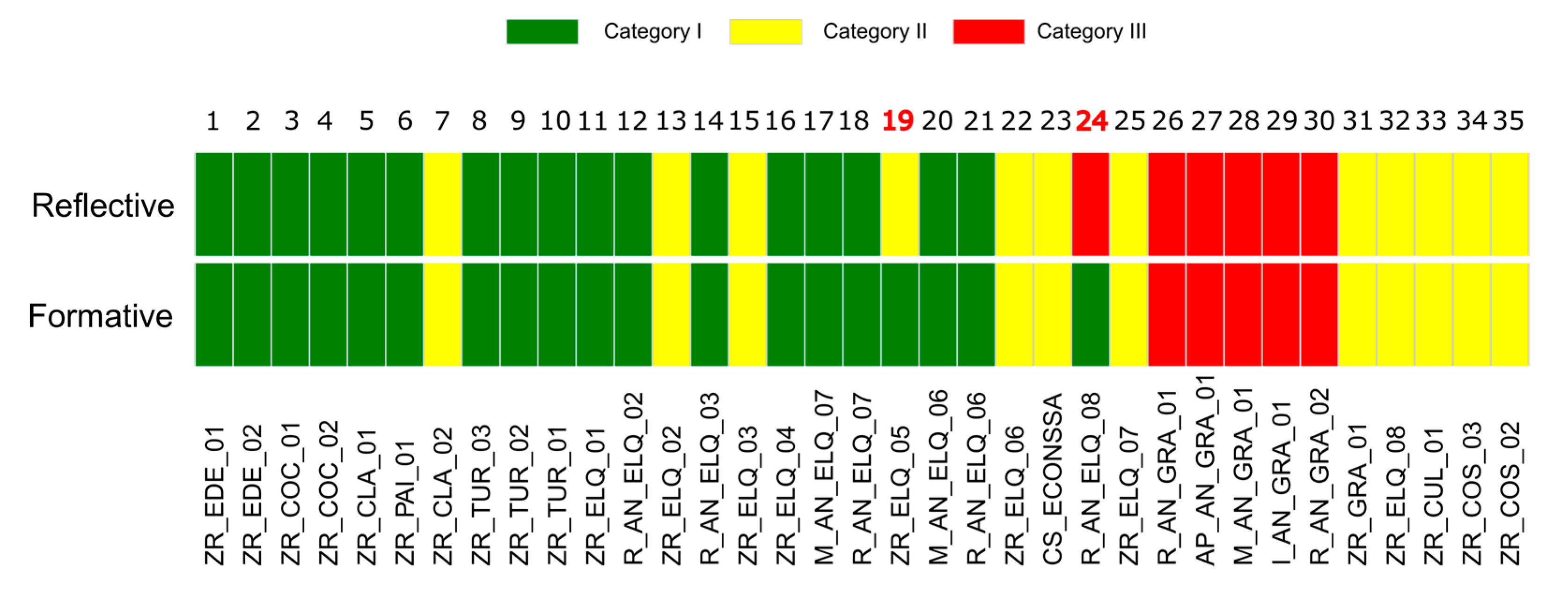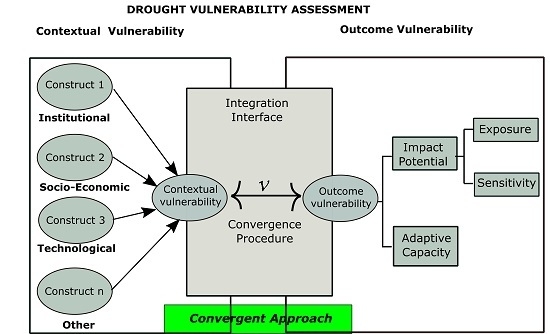1. Introduction
Drought has been, is, and most likely will continue to be one of the most significant socio-natural disasters affecting society and the environment worldwide.
Although there has been ongoing discussion regarding the occurrence, trends and uncertainty in the frequency of droughts globally [
1,
2,
3,
4], an objective fact is that this phenomenon caused more than half of the deaths associated with natural disasters worldwide during the 20th century and, after floods, was the natural disaster with the second-greatest human impact [
5,
6]. In fact, according to the United Nations Office for Disaster Risk Reduction [
7], 50.5 million people were affected by drought worldwide in 2015 alone. A similar figure was indicated by Stanke et al. [
8] for 2011.
International concern about the global impact of drought motivated the organization, in 2013, of a High-Level Meeting on National Drought Policy (HMNDP), organized in a joint effort by the United Nations Convention to Combat Desertification and Drought (UNCCD), the Food and Agriculture Organization (FAO) and the World Meteorological Organization (WMO) [
6]. As a result, recommendations from the perspectives of policy and science were developed. In the latter case, one of the five key elements through which science can support a national drought management policy consists of “Promoting standard approaches to vulnerability and impact assessment” [
9], an issue that is gaining importance in both science and policy-making and has even been classified as an urgent matter [
6].
It has been recognized that the work of Adger [
10] regarding the state-of-the-art of vulnerability assessment in connection with climate change gave a significant boost research on vulnerability to a changing climate. Although the conceptual framework in this field has incorporated new theoretical frameworks in recent decades [
11,
12,
13,
14,
15,
16], it is possible to highlight two main paradigms that have defined the way in which academia has conceptualized and operationalized vulnerability [
15,
17,
18,
19]: the contextual framework (also known as start-point vulnerability) and the outcome framework (also known as end-point vulnerability). In the former case, vulnerability is conceptualized around intrinsic factors—or characteristics—of the impacted system and is operationalized, broadly, in terms of so-called composite indicators [
14]. In the second case, vulnerability is conceptualized as a functional relationship between the stressor and the response of the impacted system. To this end, it relies on a metric based on changes in the relevant variables due to changes in the stressor and its relationship to certain thresholds.
The main problem arising from the application of both frameworks—especially for promoting standard vulnerability assessment approaches—is what specialists understand as a lack of reconciliation between approaches that, in practice, address the exact same objects of study [
17,
19]. This issue can be considered relevant because it is not simply a matter of semantic differences, but rather two diametrically opposite positions in the conceptualization, diagnosis and subsequent reduction of vulnerability. Furthermore, as O’Brien et al. [
18] have argued, “because the two interpretations are rooted in different discourses and differ fundamentally in their conceptualization of the character and causes of vulnerability, they cannot be integrated into one common framework”. Contrary to this assertion, the authors of the present study believe that, in fact, there is space for reconciliation of this epistemic divorce and, therefore, present a conceptual/methodological/statistical approach called the
convergent approach. It goes without saying that this tenet lies within the scope of the so-called integral frameworks [
12]—also known as synthetic or hybrid [
20]—which are regarded as the current paradigm in climate change vulnerability analysis. According to the latter authors, the integral framework “provides a broad conceptual and analytical platform by allowing the integration and application of different conceptual backgrounds as well as a range of methods and tools that have the potential to complement each other and improve the information provided”. Accordingly, and following Newell et al. [
21], this study contributes to the effort to “develop ways to overcome existing conceptual barriers to integration “between” well-known and formidable cultural barriers”.
To this end, this work presents an application study carried out in the Elqui River basin (ERB), which is located on the southern border of the Atacama Desert in the arid region of north-central Chile. Specifically, this research makes use of a convergent approach to assess the vulnerability of water security to drought among water users in the ERB. The adoption of water security as a study object in the context of drought vulnerability is justified since it has emerged in the past two decades as a new paradigm that has attracted a considerable amount of attention not only in the academic field but also in public policy decision-making [
22]. Within this paradigm, the perspective of risk, which includes vulnerability as one of its dimensions [
15], has started to gain prevalence in water security studies [
23]. This fact is reflected in the widely accepted definition of water security provided by Grey et al. [
24] in terms of “a tolerable level of water-related risk to society”. In this context, drought is predominantly considered a key determinant with respect to water security for water-use sectors [
23,
25,
26], whereas the concept of vulnerability has gained predominance in research areas such Climate Change Adaptation (CCA), Disaster Risk Reduction (DRR) [
15] and water security [
23,
25,
27].
Consequently, the aim of this study is to analyze, by means of a convergent approach, the vulnerability of water security to drought events in the Elqui River basin, Coquimbo Region, Chile. It is expected that the results of this research will achieve three objectives, two of which are presented in the HMNDP Scientific Document [
9]: first, to strengthen the standard approaches to vulnerability assessment; second, to integrate science with the policy aspects of drought, with the understanding that a robust measure of vulnerability is an important and urgently needed tool for drought management [
6] and third, to contribute to the adoption of integral frameworks to assess drought vulnerability [
12,
20,
21].
3. Results
Figure 4 shows outcome sensitivity (vulnerability)—both derived from Equation (1) and estimated using Equation (4) based on Luers et al. [
37] model-based approach under the outcome vulnerability framework (
Figure 1)—of water security under drought events for water-use sectors (WEAP-Elqui nodes) in the ERB according to simulated scenarios.
Sensitivity (the degree of change in coverage with respect to , according to Equation (4), increases in the downstream direction of ERB, particularly from the confluence of the Turbio and Claro rivers. In the upper sector, irrigated zones (ZR) above the Derecho River (EDE) show higher sensitivity. That is, a high variation in drought intensity produces a high variation in the water coverage of this water-use sector. This may be due to the fact that the water distribution in the area is managed by an organization (DRWBother than that of the Elqui River, and therefore subject to different regulations. Sensitivity is influenced by the simulation scenarios, and is higher in conditions of aquifer absence and Drought Coefficient absence. The highest sensitivity values for the ERB are found, from lowest to highest, in: irrigated zones in Santa Gracia Creek (ZR-GRA_01), drinking water production for the La Serena-Coquimbo conurbation (CS_ECONSSA) and the irrigated area situated above the Culebrón aquifer (ZR_CUL_01). Vulnerability of water security to drought events, which, in accord with Equations (1) and (4), is understood as the susceptibility of the water-use sector to drought damage as a result of its sensitivity, status with respect to a threshold level and exposure to the phenomenon, as with sensitivity, is a function of (a) the location of water-use sectors (node) in the basin and (b) the selected simulation scenario. In the first case, vulnerability is higher downstream in the basin, showing intermediate values (2–6) in nodes located on the Elqui River (ELQ), and moderate to high values in nodes such as Santa Gracia Creek (GRA) and Culebrón aquifer (CUL). The lowest vulnerability values are found in the upper part of the basin at the convergence of the Claro (CLA) and Turbio (TUR) rivers. The areas that are permanently irrigated (ZR) by the three main rivers in the ERB show less vulnerability compared to areas where irrigation relies on natural sources (R). However, for the mining activity (M) that makes use of water from natural sources (AN), vulnerability depends more on its location in the basin than the stability of the source.
As for scenarios, the more restrictive they become (A to D), the higher the vulnerability values they show, though only in nodes that represent irrigated agricultural sectors (ZR,R) with access to aquifers. Scenarios without the Drought Coefficient (C,D) are more vulnerable, which is consistent with the hypothesis that drought conceals its direct impact on water security if the latter is calculated in terms of the water coverage of the node, as proposed by the WEAP-Elqui model by RHODOS [
73]. Scenarios without an aquifer (B,D) are more vulnerable than those with an aquifer (A,C). The greatest effect appears in the Culebrón aquifer (CUL), in the agricultural sector known as Pan de Azúcar (
Figure 3). This aquifer is the most important in the ERB since it accounts for the 39% of the total groundwater storage capacity in the basin. In the upper areas of the basin, at the confluence of the Turbio and Claro rivers, the general pattern shows low or no vulnerability. Only some sectors show an increase in vulnerability under the scenario without an aquifer, such as those linked to the Derecho River (EDE) and stretches of the Turbio River. In order to determine if the Drought Coefficient and Aquifer Presence/Absence factors included in the simulation scenarios significantly affect mean drought vulnerability in irrigated zones (ZR), a two-way analysis of variance (ANOVA) without interaction and Tukey’s HSD (Honestly Significant Difference) post hoc test for samples of equal size were applied. The latter procedure allows the comparison of all pairs of means. When used with equal sample sizes, the family-wise error rate is exactly equal to
α, which was set at 0.05 in this case [
109]. The analysis confirmed the statistical significance of both the Drought Coefficient factor (
p < 0.0286) and the Aquifer Presence/Absence factor (
p < 0.0221). This is a significant issue since the agricultural sector is the main water user in the basin [
64,
69].
Figure 5 shows the Theoretical and Final contextual vulnerability models, whereas
Table 6 shows the performance of the proposed models. As for the Theoretical Model, only three of the six proposed constructs (hydrology-sensitivity, hydrology-adaptability, productive-adaptability) show values that are considered sufficient for the criteria included in the measurement model (reliability and validity of construct). This fact corroborates the existing consensus on the effect that subjectivity exerts on the selection, combination and weighting of the indicators in use when constructing composite indicators [
31,
47,
48,
62]; it also explains the high diversity of current methodological approaches for the construction of this type of indicator. The structural model, meanwhile, exhibited a moderate predictive capacity (
R2 = 0.58), but no path coefficients (
β) appeared to show statistical significance [
58]. Thus, the proposed Theoretical Model does not apply as an explicative model for the vulnerability of water security to drought in the ERB [
58,
60,
61].
The Final Model, on the other hand, appears to satisfy the performance criteria for the measurement model (reliability and validity) and the structural model (
β,
R2). This model is composed of four constructs and kept 10 out of the 25 original indicators, a number of indicators on the low end of the range that is commonly used in the construction of composite indicators and drought vulnerability studies [
31,
33,
35,
48,
95,
96]. The Location construct is reflected in the indicators for node’s position in the basin (East–West Geographical Position [EWP], Distance to Main Canal [DMC]) and confirms the significant role that this construct plays in the spatial distribution of vulnerability in the ERB, as was previously noted in the estimation of outcome vulnerability. The Water Supply construct is reflected in indicators (Canal Infrastructure [CI], Canal Maximum Flow [CMF], Streamflow [STF]) that efficiently supply water to the water-use sector. The Infrastructure construct is reflected in the Water Control Infrastructure [WCI] indicator, which includes the number of automatic gates in the canal system that feeds each node. The Water Stability construct includes indicators (Groundwater Users [NGU], Node Immobility [NI], Groundwater Extraction [GE], User Size [US]) that relate to the capacity of the water system to provide conditions of stability to the water-use sector (node). Thus, the proposed constructs implicitly include the notions of exposure (Location), sensitivity (Water Stability) and adaptive capacity (Infrastructure, Water Supply), which are also components of the theoretical model of vulnerability proposed by Turner et al. [
11]. The predictive capacity of the model is significant (
R2 = 0.67) [
58], thus confirming what Trinchera and Russolillo [
62] state about the capacity of SEM-PLSPM to cope with subjective elements in the construction of composite indicators.
Concerning the sensitivity of the Final Model, model stability for a statistical power of 80% was reached for
n = 23, a value that is less than the total
N = 35 used in the modeling process. This value is consistent with that reported by Hair et al. [
60] (
N = 33) for α = 0.05, four constructs, a
R2 = 0.75 and a statistical power of 80%. The lowest value of n in the Final Model is explained by a lower value of
R2 (0.67), which in turn generates a lower size effect (
f2 = 0.3). In the case of the measurement model misspecification—the specification of the measurement model as reflective or formative—as shown in
Figure 6, only two of the 35 nodes showed differences in allocation in the vulnerability category depending on the type of measurement model, although the predictive performance decreased to a
R2 = 0.55 (moderate). Accordingly, and in line with Minotti et al. [
100], the misspecification of either a reflective or formative model did not imply a significant impact on the estimation of the vulnerability category under which a water user is placed by the Final Model.
The robustness of the Final Model is confirmed in
Table 7, which shows
R2 values for the six alternatives for contextual vulnerability assessment under study. Accordingly, the SEM-PLSPM-based convergent approach shows one of the highest
R2 values, slightly less than random forest, which is one of the algorithms with the highest predictive performance but lacks the ability to adjust indicators to a theoretical model [
58,
61]. The high predictive performance of SEM-PLSPM, (
R2 = 0.91), slightly higher than random forest when isolated indicators are considered (SEMmax), should also be noted. Alternatives commonly used in the construction of composite indicators (PCA, FA, SES) and more recent proposals (BoD, RBoD) show a very low predictive performance, which confirms the soundness of the convergent approach proposed in this study as a means of advancing toward an objective assessment of vulnerability.
4. Discussion
Drought has been, is, and most likely will remain one of the most significant socio-natural disasters affecting society and the environment worldwide. “Promoting standard approaches to vulnerability and impact assessment” [
9] is an issue that is gaining importance in both science and policy-making, to the extent that it is considered a priority [
6]. The need to face this urgency, however, makes it necessary to acknowledge the lack of reconciliation between the two mayor epistemic frameworks (contextual and outcome) that deal with vulnerability assessment [
15,
17,
19]. Some authors have suggested, prematurely perhaps, that “because the two interpretations are rooted in different discourses and differ fundamentally in their conceptualization of the character and causes of vulnerability, they cannot be integrated into one common framework” [
18]. This view, however, has been challenged in recent years by the so-called integral frameworks (holistic, synthetic or hybrid) [
12,
20]. This development holds promise insofar as, at least in the case of drought, although it is similar to other areas concerning vulnerability to natural disasters [
13], the contextual framework has been the most frequently employed [
16]. Nonetheless, this work proposes a new approach—the convergent approach—to assess vulnerability within the integral framework. Vulnerability is assessed in the context of water security, which is now considered a new paradigm in both the academic and public policy fields concerning water resources [
22,
23,
27]. The convergent approach, herein presented in conceptual, methodological and statistical terms, is applied to the analysis of the vulnerability of water security to drought in water-use sectors in the Elqui River basin, a typical basin of the mountainous area in the arid region of north-central Chile [
25,
64].
Vulnerability is estimated primarily under an outcome approach by means of a metric based on the proposal presented by Luers et al. [
37]. With water security defined in terms of coverage of the demands of water users in the ERB, the results show high heterogeneity in vulnerability to drought within the basin. This heterogeneity exists basically as a function of spatial location in the basin and the simulation scenarios generated for comparison purposes. In the first case, the inequality in vulnerability within the ERB (Gini coefficient = 0.62) shows an east–west component downstream that allows a quasi-structural explanation derived from the historical water distribution practices carried out by different Water Users Organizations [
69,
70]. This finding is confirmed by the almost null coverage sensitivity to the hydrological drought in the upper sector of the basin, while in the lower sectors, where the highest demands are found in the urban sector (La Serena-Coquimbo conurbation) and the vast Pan de Azúcar agricultural area situated above the Culebrón aquifer [
68], sensitivity and vulnerability show the highest values in the basin. This finding alone is very important if it is analyzed from the science-policy interface and as input for decision-making by stakeholders, especially in a moment in which water legislation in Chile is undergoing a debated reform process triggered by, among other aspects, the impact of drought and water scarcity in a large part of the country in the last decade. Although a detailed analysis of this aspect goes far beyond the objectives of this study, it shows the potential of the convergent approach—in the context of the integral framework—to provide information on the role that factors that are so sensitive to public opinion such as unequal water distribution play in the vulnerability of water security to drought events.
Vulnerability increases noticeably in scenarios without an aquifer—a highly probable scenario when there is unsustainable exploitation of aquifers during drought events [
82], a practice for which there is already evidence in north-central Chile [
110] in general and in the ERB in particular [
68,
69]. This is also the case when the impact of drought on water coverage is revealed by disregarding the effect of the so-called Drought Coefficient in the WEAP-Elqui model [
73]. Both effects are statistically significant, mainly in irrigated agricultural zones (ZR), in which the major water users in the basin are located [
64]. Thus, the outcome approach allows the question of
who is vulnerable to drought in the basin to be answered [
16,
21].
If the question expands to include
why they are objectively vulnerable, the answer—estimated on the basis of a set of 10 indicators combined in a structured model of four constructs that was made to converge with the outcome estimation—includes factors that are compatible with those related to exposure, sensitivity and adaptive capacity in the vulnerability model proposed by Turner et al. [
11], which Zarafshabi et al. [
16] consider essential in any model that attempts to assess drought vulnerability. These factors include Location, Water Supply, Infrastructure and Water Stability.
The Final Model of water security vulnerability to drought is considered stable for the available sample size thanks to its high
R2 (0.67) and the corresponding size effect (
f2 = 0.3) for a statistical power of 80% [
60]. Stability is also maintained with respect to an error due to misspecification of the measurement model, since this aspect does not cause a significant change in the category of vulnerability to which a determined node is assigned. At the same time, the robustness of the model has been confirmed after comparison with six alternative methods traditionally used in the construction of composite indicators. This finding takes on special relevance in view of the call to integrate sensitivity analysis in the construction of composite indicators [
48,
111]. Robustness is a key factor in the construction of vulnerability assessment models. The iterative process that underlies the convergent procedure implies a convergence of the so-called deductive (theory-driven) and inductive (data-driven) approaches [
13], acting as a filter for an objective selection of indicators. Meanwhile, performance requirements (measurement and structural models) constrain an
ad hoc combination of indicators, which ameliorates the problem of misspecification of the model. The combined use of the stability criteria of the sample size, misspecification error and comparability allow the requirements of reliability (akin to the concept of precision) and validity (akin to the concept of accuracy) to be adequately addressed when assessing vulnerability [
112] due to the fact that the commonly recommended sensitivity methods essentially focus on the former [
111]. This is an aspect that is not commonly addressed ex ante in the construction of vulnerability composite indicators in general, and in composite indicators of vulnerability to drought in particular, despite the low validity (53%) shown by well-known resiliency and vulnerability indicators [
113]. As a conclusion, and in agreement with Nardo et al. [
111] and Balica [
13], the authors of the present study claim that the convergent approach constitutes a methodological process qualitatively fitted for the construction of a vulnerability assessment model whose results improve the perception of reality regarding the vulnerability of water security to drought in the ERB.
It should be pointed out that the convergent approach presented in this study has been applied under restrictive methodological conditions due to the spatial scale (basin), since at this scale the availability of data for a single unit of analysis (water user sector) is limited, such as when the unit of analysis corresponds to spatial administrative units [
57]. Fewer constraints may appear if the units of analysis are compatible with both approaches, as could be the case with administrative units at a national scale, without compromising the sample size. For example, Naumann et al. [
31] estimate vulnerability to drought at a pan-African scale, which allows a greater availability of data for contextual estimation due to the unit of analysis (country), although sample size (12) could prove to be insufficient for an estimation based on SEM-PLSPM, even if a high
R2 value is obtained. This problem could be tackled, however, by expanding the analysis of the mentioned authors to a global scale under the convergent approach, assuming at the same time that it is possible to obtain an outcome estimation of vulnerability in the same units of analysis. In this sense, the procedure developed by Naumann et al. [
114] to estimate drought damage could constitute an initial approach to determine outcome vulnerability. A similar perspective could be used to adopt the convergent approach to global estimation of vulnerability to drought recently developed by Carrão et al. [
33]. In this case, the selected indicators for a predefined spatial resolution compatible with the Global Administrative Unit Layers (GLU) could be used in the construction of a structural model and test its convergence with respect to global estimations of vulnerability to drought, such as that presented by Guo et al. [
42] for the same spatial resolution. This would imply certain advantages for the sensitivity and robustness of the model in terms of sample size, but constraints could appear in terms of amount, quality and relevance of the available indicators with respect to a theoretical model for vulnerability to drought at that spatial scale [
31].
